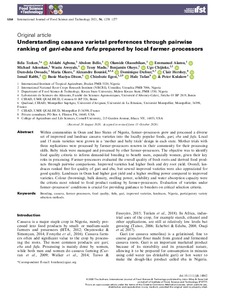| dc.contributor.author | Teeken, B. |
| dc.contributor.author | Agbona, A. |
| dc.contributor.author | Bello, A.A. |
| dc.contributor.author | Olaosebikan, O. |
| dc.contributor.author | Alamu, E.O. |
| dc.contributor.author | Adesokan, M. |
| dc.contributor.author | Awoyale, W. |
| dc.contributor.author | Madu, T. |
| dc.contributor.author | Okoye, B. |
| dc.contributor.author | Chijioke, U. |
| dc.contributor.author | Owoade, D. |
| dc.contributor.author | Okoro, M. |
| dc.contributor.author | Bouniol, A. |
| dc.contributor.author | Dufour, D. |
| dc.contributor.author | Hershey, C. |
| dc.contributor.author | Rabbi, I.Y. |
| dc.contributor.author | Maziya-Dixon, B. |
| dc.contributor.author | Egesi, C. |
| dc.contributor.author | Tufan, H.A. |
| dc.contributor.author | Kulakow, P. |
| dc.date.accessioned | 2021-04-27T08:57:54Z |
| dc.date.available | 2021-04-27T08:57:54Z |
| dc.date.issued | 2021 |
| dc.identifier.citation | Teeken, B., Agbona, A., Bello, A.A., Olaosebikan, O., Alamu, E.O., Adesokan, M., ... & Kulakow, P. (2021). Understanding cassava varietal preferences through pairwise ranking of gari-eba and fufu prepared by local farmer–processors. International Journal of Food Science and Technology, Vol 56, 1258–1277. |
| dc.identifier.issn | 0950-5423 |
| dc.identifier.uri | https://hdl.handle.net/20.500.12478/7103 |
| dc.description.abstract | Within communities in Osun and Imo States of Nigeria, farmer–processors grew and processed a diverse set of improved and landrace cassava varieties into the locally popular foods, gari, eba and fufu. Local and 15 main varieties were grown in a ‘mother and baby trials’ design in each state. Mother trials with three replications were processed by farmer–processors renown in their community for their processing skills. Baby trials were managed and processed by other farmer–processors. The objective was to identify food quality criteria to inform demand-led breeding to benefit users, especially women, given their key roles in processing. Farmer–processors evaluated the overall quality of fresh roots and derived food products through pairwise comparisons. Improved varieties had higher fresh and dry root yield. Overall, landraces ranked first for quality of gari and eba, but several improved varieties were also appreciated for good quality. Landraces in Osun had higher gari yield and a higher swelling power compared to improved varieties. Colour (browning), bulk density, swelling power, solubility and water absorption capacity were the criteria most related to food product ranking by farmer–processors. Evaluation of varieties under farmer–processors’ conditions is crucial for providing guidance to breeders on critical selection criteria. |
| dc.description.sponsorship | CGIAR Research Program on Roots, Tubers and Bananas |
| dc.description.sponsorship | CGIAR Fund Donors |
| dc.description.sponsorship | Bill & Melinda Gates Foundation |
| dc.description.sponsorship | Department for International Development, United Kingdom |
| dc.format.extent | 1258–1277 |
| dc.language.iso | en |
| dc.subject | Cassava |
| dc.subject | Garri |
| dc.subject | Food Quality |
| dc.subject | Nigeria |
| dc.subject | Varieties |
| dc.subject | Farmers |
| dc.subject | Processing |
| dc.subject | Plant Breeding |
| dc.title | Understanding cassava varietal preferences through pairwise ranking of gari-eba and fufu prepared by local farmer-processors |
| dc.type | Journal Article |
| cg.contributor.crp | Agriculture for Nutrition and Health |
| cg.contributor.crp | Maize |
| cg.contributor.crp | Roots, Tubers and Bananas |
| cg.contributor.affiliation | International Institute of Tropical Agriculture |
| cg.contributor.affiliation | National Root Crops Research Institute, Nigeria |
| cg.contributor.affiliation | Université d’Abomey-Calavi |
| cg.contributor.affiliation | Cornell University |
| cg.contributor.affiliation | Kwara State University |
| cg.contributor.affiliation | Centre de Coopération Internationale en Recherche Agronomique pour le Développement |
| cg.contributor.affiliation | Université de Montpellier |
| cg.contributor.affiliation | Private Consultant, USA |
| cg.coverage.region | Africa |
| cg.coverage.region | West Africa |
| cg.coverage.country | Nigeria |
| cg.coverage.hub | Headquarters and Western Africa Hub |
| cg.researchtheme | Biotech and Plant Breeding |
| cg.researchtheme | Nutrition and Human Health |
| cg.researchtheme | Plant Production and Health |
| cg.researchtheme | Social Science and Agribusiness |
| cg.identifier.bibtexciteid | TEEKEN:2020 |
| cg.isijournal | ISI Journal |
| cg.authorship.types | CGIAR and developing country institute |
| cg.iitasubject | Agronomy |
| cg.iitasubject | Cassava |
| cg.iitasubject | Food Security |
| cg.iitasubject | Plant Breeding |
| cg.iitasubject | Plant Production |
| cg.iitasubject | Smallholder Farmers |
| cg.iitasubject | Socioeconomy |
| cg.iitasubject | Value Chains |
| cg.journal | International Journal of Food Science and Technology |
| cg.notes | Open Access Article; Published online: 21 Oct 2020 |
| cg.accessibilitystatus | Open Access |
| cg.reviewstatus | Peer Review |
| cg.usagerightslicense | Creative Commons Attribution 4.0 (CC BY 0.0) |
| cg.targetaudience | Scientists |
| cg.identifier.doi | https://dx.doi.org/10.1111/ijfs.14862 |
| cg.iitaauthor.identifier | Béla Teeken: 0000-0002-3150-1532 |
| cg.iitaauthor.identifier | Bello Abolore: 0000-0002-8871-6163 |
| cg.iitaauthor.identifier | Alamu Emmanuel Oladeji (PhD, FIFST, MNIFST): 0000-0001-6263-1359 |
| cg.iitaauthor.identifier | Olamide Olaosebikan: 0000-0003-1470-1150 |
| cg.iitaauthor.identifier | Wasiu Awoyale: 0000-0002-3635-1414 |
| cg.iitaauthor.identifier | Okoye Benjamin: 0000-0003-2458-5587 |
| cg.iitaauthor.identifier | UGO CHIJIOKE: 0000-0001-6983-5215 |
| cg.iitaauthor.identifier | Alexandre Bouniol: 0000-0002-6140-424X |
| cg.iitaauthor.identifier | Clair Hershey: 0000-0002-2412-6228 |
| cg.iitaauthor.identifier | Ismail Rabbi: 0000-0001-9966-2941 |
| cg.iitaauthor.identifier | Busie Maziya-Dixon: 0000-0003-2014-2201 |
| cg.iitaauthor.identifier | Chiedozie Egesi: 0000-0002-9063-2727 |
| cg.iitaauthor.identifier | Hale Ann Tufan: 0000-0002-5323-4244 |
| cg.iitaauthor.identifier | Peter Kulakow: 0000-0002-7574-2645 |
| cg.futureupdate.required | No |
| cg.identifier.volume | 56 |

